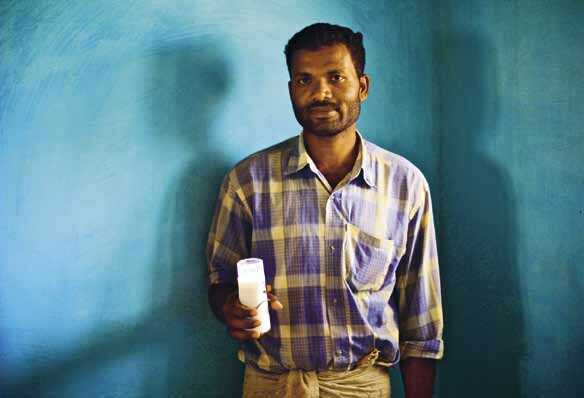It is Rural Spark’s ambition to encourage smart grids, specifically in developing countries, enabling their citizens to leapfrog traditional top-down, centralised energy grids. “Rural Spark empowers local stakeholders to grow an autonomous functioning network, in which energy, information, maintenance, and profits are distributed on all levels, thereby actively participating in the growth of an open, new world energy market from the bottom-up,” it sums up its mission.
Villagers turned entrepreneurs
Rural Spark has taken on the challenge to shape the distributed energy networks of the future, starting in rural India. By way of an iterative method, it develops special kits that allow local villagers to generate energy themselves. The context-specific kit includes something that can function as their energy source. Depending on the setting, this may come in the form of a solar panel or a tiny hydroelectric power station. The kit also includes an energy router that enables the villager to channel the energy and share it with his fellow villagers in return for a small fee. It turns him or her into a veritable entrepreneur overnight: fellow villagers will drop off their chargeable items
in the morning and retrieve them in the evening, along with having a cup of tea and discussing the local news. These village-level entrepreneurs make a tangible difference in their communities, while earning both money and social
status for themselves. Rural Spark takes responsibility for the
relatively high costs of setting up the system’s infrastructure, while local entrepreneurs pay a monthly subscription fee that ensures proper local maintenance of the network, continuity and reliability. Although the traditional source of energy in rural India—kerosene and firewood —is relatively cheap, the sun, the wind, and water are ultimately sources of energy that come free of charge. Also, they are safe, clean, and sustainable. That’s how the initial investment that is required to become part of the Rural Spark energy network pays off quickly and on different levels.
There’s more
On sunny days, energy suppliers that make use of a solar panel are able to generate far more energy than they actually need. To capture this energy, Rural Spark has introduced Share Cubes that enable an entrepreneur to store surplus energy. In this way, surplus energy is no longer wasted but, instead, it can be traded on an emerging market of supply and demand. On a windy but cloudy day, an entrepreneur that makes use of wind-powered energy can sell his surplus to his fellow entrepreneurs that are depending on the power of the sun. By the exchange of energy surpluses, a reliable distributed network is taking shape that is able to accommodate both supply and demand in a far cheaper way than centralised, top-down energy networks are able to do.
Design in context
“Many products are being developed in a faraway lab and do not actually accommodate the local context, because they do not take into account the many stakeholders and factors that influence local culture,” co-initiator Van Heist says. That’s why Rural Spark makes an effort to actually physically move into the local situation and to design on the spot—in an explicitly demand-driven way. To this end, an agile design process is used with short feedback cycles, from Research & Development to implementation in the field. This allows for a process of rapid prototyping within the local situation that involves all stakeholders.
Opportunity through scarcity
Currently, approximately 400 million rural Indians are living without access to electricity. The gap between the quality of life of the urban rich and the rural poor is widening. In spite of the dim circumstances of many rural Indians, design features Rural Spark views their current situation as an
opportunity. The sheer lack of infrastructure that currently exists offers the opportunity to start fresh. That’s why Rural Spark leaves the beaten track of top-down government intervention. Instead, it directly involves the people themselves, offering them responsibility, direct returns, and livelihood.
Bottom-up community building
Besides economic and environmental benefits, the bottom-up sharing of energy is proving to have vast social effects on the village level. For the empowered entrepreneur, it increases
ownership. Also, social cohesion increases between all stakeholders involved. This provides an extra social incentive to both the consumer and the entrepreneur to take care of the system, ensuring its continuation. Together, the villagers are using solar energy in an altogether new way, enhancing the feeling of community and collective responsibility.

Leave a comment